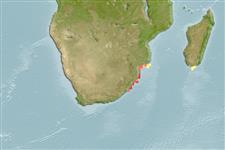Environment: milieu / climate zone / depth range / distribution range
Sinh thái học
Biển Cùng sống ở rạn san hô; Mức độ sâu 20 - 50 m (Ref. 4319). Subtropical; 25°S - 33°S, 30°E - 46°E (Ref. 5222)
Western Indian Ocean: known only from Madagascar, Natal in South Africa, and southern Mozambique.
Bộ gần gũi / Khối lượng (Trọng lượng) / Age
Maturity: Lm ? range ? - ? cm
Max length : 100.0 cm TL con đực/không giới tính; (Ref. 4319); Khối lượng cực đại được công bố: 10.0 kg (Ref. 4319)
Các tia vây lưng cứng (tổng cộng) : 11; Các vây lưng mềm (tổng cộng) : 15 - 16; Tia cứng vây hậu môn: 3; Tia mềm vây hậu môn: 9. Distinguished by the following characteristics: body color dark reddish brown; head and body covered with small, irregular, close-set, dark red or reddish brown spots, pale interspaces forming irregular pale network pattern; 4 narrow, irregular, oblique, pale bars running down and forward on body; paired fins generally darker than body; body depth contained 3.1-3.5 times in SL; body width 1.7-2.0 times in depth; head length 2.3-2.4 times in SL; interorbital width 5.9-6.8 times in HL; concave interorbital area; rounded preopercle, finely serrate, shallow indentation just above angle; upper edge of operculum almost straight; inconspicuous opercular spines; posterior and anterior nostrils subequal; maxilla not reaching past eye; front of upper jaw with a pair of large, curved, fixed canines and a pair of similar but slightly smaller canines at front of lower jaw; lateral part of lower jaws with an outer row of 8-9 slightly smaller fixed canines and an inner row of smaller , more slender depressible teeth (Ref. 89707).
Appears to be a rare species, but it is of some importance to South African sport fishers along the northern coast of Natal. Coral reef-associated species inhabiting depths of 20-50 m (Ref. 89707). Feeds on fishes and invertebrates (Ref. 89707). Testes of a 61 cm SL specimen contained a central lumen and numerous 'brown bodies' along the lateral edges of the gonadal lamellae.
Life cycle and mating behavior
Chín muồi sinh dục | Sự tái sinh sản | Đẻ trứng | Các trứng | Sự sinh sản | Ấu trùng
Heemstra, P.C. and J.E. Randall, 1993. FAO Species Catalogue. Vol. 16. Groupers of the world (family Serranidae, subfamily Epinephelinae). An annotated and illustrated catalogue of the grouper, rockcod, hind, coral grouper and lyretail species known to date. Rome: FAO. FAO Fish. Synop. 125(16):382 p. (Ref. 5222)
IUCN Red List Status (Ref. 130435: Version 2024-1)
Threat to humans
Harmless
Human uses
Các nghề cá: Các nghề cá là sinh kế; cá để chơi: đúng
Các công cụ
Special reports
Download XML
Các nguồn internet
Estimates based on models
Preferred temperature (Ref.
123201): 23.7 - 24.7, mean 24.2 °C (based on 4 cells).
Phylogenetic diversity index (Ref.
82804): PD
50 = 0.5000 [Uniqueness, from 0.5 = low to 2.0 = high].
Bayesian length-weight: a=0.01175 (0.00568 - 0.02430), b=3.04 (2.88 - 3.20), in cm total length, based on LWR estimates for this Genus-body shape (Ref.
93245).
Mức dinh dưỡng (Ref.
69278): 4.0 ±0.6 se; based on size and trophs of closest relatives
Thích nghi nhanh (Ref.
120179): Rất thấp, thời gian nhân đôi của chủng quần tối thiểu là hơn 14 năm (Preliminary K or Fecundity.).
Fishing Vulnerability (Ref.
59153): High vulnerability (60 of 100).
